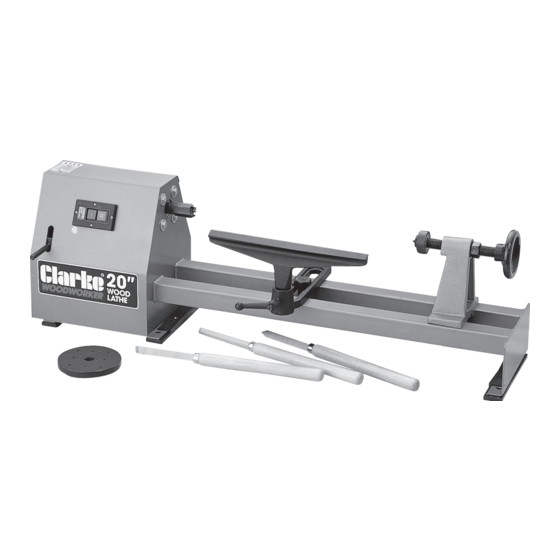
Summary of Contents for Clarke CWL6B
- Page 1 20” WOODLATHE 20” WOODLATHE Model No. CWL6B Part No. 6501650 OPERATING & MAINTENANCE INSTRUCTIONS 0302...
- Page 2 PARTS DIAGRAM CONTENTS Page Lathe Specifications ....................3 General Safety Instructions ..................4 Wood Lathe Safety Instructions ................. 5 Electrical Connections and Motor Specifications ........... 6 Unpacking And Checking Contents ................ 7 Spindle Speeds and Belt Tensioning ................. 8 Preparation for use (Spindle/Faceplate/Outboard Turning & Indexing) ..... 9 Using Woodworking Chisels and Basic Techniques ..........
- Page 3 SD60231 Spindle Pulley SD6007 32 Bolt SD6032 This CLARKE product is guaranteed against faulty manufacture for a period of 12 months from the Motor Pulley SD6008 33 Lock Knob SD6033 date of purchase. Please keep your receipt as it will be required as proof of purchase. This guarantee...
- Page 4 KEEP CHILDREN AND VISITORS AWAY. inspected to ensure that it can perform its’ For spare parts or servicing, please contact your nearest Clarke dealer or Clarke International on intended function correctly. If in doubt, the All children and visitors should be kept a one of the following numbers.
- Page 5 glued or tacked in place, do satisfactory work. 4. USE OF WOOD CHUCKS FOR ADDITIONAL SAFETY RULES FOR WOOD LATHES These have the advantage that special sizes, SANDING tapers etc., can be made. IMPORTANT: You should not operate this headstock. Always set the workpiece into Quick acting chucks can be very useful for Fig.
- Page 6 ELECTRICAL CONNECTIONS SANDING, BUFFING AND POLISHING Connect the mains lead to a standard 230 volt (50Hz) electrical supply using a 13 amp BS1363 plug Fig. 56 The application of the sandpaper strip is shown fitted with a 13 amp fuse. or a suitably fused isolator switch. in fig.
- Page 7 There are two general groups of plastics. The first SIMILAR OPERATIONS If any parts are missing or damaged in any way, please contact your Clarke dealer immediately. includes all phenol plastics moulded under heat and pressure. Bakelite and Formica are Ensure the lathe is secured firmly to a firm level surface...a sturdy workbench for example, or, if...
- Page 8 the ball is constantly shifted, never more than Fig. 51 SPINDLE SPEEDS 1/8 turn and always with a definite pattern. Since turning between centres makes the work a A chart showing spindle speeds and recommended turning speeds is mounted on the Head cowl perfect sphere across the grain, the ball must and for convenience, is duplicated as follows: be mounted in the chuck so that the first...
- Page 9 and mounted on this chuck. thus mounted, the After being chucked the remaining face of the PREPARATION remaining contours can be turned to shape. ring can be turned to the proper contour, thus cutting away the centre portion. Fig. 47 1.
- Page 10 FANCY FACE PLATE TURNINGS 2. FACEPLATE TURNING Fig. 43 All face plate work is done by scraping. Any Turning which cannot be worked through After making a recess at least 1/2 the way attempt to use a cutting technique on edge centres, must be mounted on a faceplate, or through the workpiece, and finishing this on the grain, will result in hogging or gouging, which...
- Page 11 FACEPLATE & CHUCK TURNINGS 3. DEEP RECESSES Fig. 40 Remove the bulk of the waste (to rough-out the desired recess), by scraping with the round-nose chisel or the gouge. Remove up to within 1/8” of finished size in this manner. Finish off the inside circumference by scraping with the spear point chisel or skew.
- Page 12 Fig. 12 An 8 piece chisel set is available from your quarter rounds will be produced. CLARKE dealer, part no. 6500649 Fig.39 2. THEORY OF TURNING There are two classes of chisel; these are : a.
- Page 13 Either a cutting or scraping action can be used chisel, then SPINDLE TURNINGS when cutting at the circumference. The shaving improperly supported is removed like a peeling from a potato. chisel will begin to 1. PLOTTING THE SHAPE 2. DUPLICATE TURNINGS bounce, or chatter, Scraping only, is used when cutting at the against the workpiece.
- Page 14 Now draw the skew straight back whilst raising Fig. 33 2.4 How to Position Tool Rest for 3. USING THE GOUGE the handle slowly, until the edge of the heel at Circumference Scraping Fig. 14 the pencil line starts to cut. As the edge begins to cut, roll the skew in the In scraping operations, the tool rest position is direction of the vee, so that the exact portion...
- Page 15 bevel side down, keep the base of the bevel scraping, when cutting methods cannot be heel of the skew into it along the surface of the 5. CUTTING A SHOULDER against the work. Good practice is to place the employed. outside area.
- Page 16 MAKING STANDARD CUTS 9. USING WOOD RASPS AND FILES 10.2 Finish Cutting Fig. 20 Fig. 22 1. THE ROUGHING OFF-CUT as desired at any spot along the work. At this stage long cuts from the centre of either Reducing a square or odd shaped workpiece end can also be taken.













Need help?
Do you have a question about the CWL6B and is the answer not in the manual?
Questions and answers